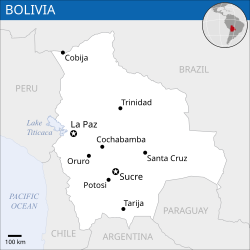မိူင်းပူဝ်ႇလီးဝီးယႃး
Appearance
| မိူင်းပူဝ်ႇလီးဝီးယႃး | |||||
|---|---|---|---|---|---|
| |||||
 ဢွင်ႈတီႈ မိူင်းပူဝ်ႇလီးဝီးယႃး (dark green) South America ၼႂ်း (grey) | |||||
 | |||||
| ဝဵင်းငဝ်ႈၸိုင်ႈ |
Sucre (constitutional and judicial) La Paz (executive and legislative) | ||||
| ဝဵင်းယႂ်ႇသေပိူၼ်ႈ |
Santa Cruz de la Sierra 17°48′S 63°10′W / 17.800°S 63.167°W | ||||
| ၽႃႇသႃႇၵႂၢမ်းတၢင်ႇၸိူဝ်း | |||||
| ၸၢဝ်းၶိူဝ်း (2018[2]) |
| ||||
| Demonym | Bolivian | ||||
| မဵဝ်းမိူင်း | Unitary presidential constitutional republic | ||||
| လူင်ပွင်ၸိုင်ႈ | |||||
• ၸွမ်ပွင်ၸိုင်ႈ | Jeanine Áñez[3][4] | ||||
• ၵႅမ်ၸွမ်ပွင်ၸိုင်ႈ | Vacant | ||||
| တႄႇတင်ႈ | |||||
• ပိုၼ်ၽၢဝ်ႇလွတ်ႈလႅဝ်းသဝ်းၶေႃ (တီႈသပဵၼ်ႇ) | 1825၊ ဢေႃးၵၢတ်ႉ 6 | ||||
• ယိုၼ်ႁပ်ႉ | 1847၊ ၵျူႇလၢႆႇ 21 | ||||
• လၵ်းမိူင်းယၢမ်းလဵဝ် | 2009၊ ၾႅပ်ႇဝႃႇရီႇ 7 | ||||
| ပိုၼ်ႉတီႈ ဢၼ်ပိူင်ႇ | |||||
• ႁူမ်ႈ | (ၸၼ်ႉ: 27th) | ||||
• လွင်ႈသတ်ႉႁူဝ်ၼပ်ႉၵူၼ်း | (ၸၼ်ႉ- 224th) | ||||
| GDP (PPP) | လၢမ်း 2019 | ||||
• ႁူမ်ႈ | $89.018 billion | ||||
• Per capita | $7,790[5] | ||||
| GDP (nominal) | လၢမ်း2019 | ||||
• ႁူမ်ႈ | $43.687 billion | ||||
• Per capita | $3,823[5] | ||||
| Gini (2018) |
ၵၢင် | ||||
| HDI (2018) |
0.703[7] သုင် · 114th | ||||
| ငိုၼ်းတွင်း | Boliviano (BOB) | ||||
| ၶၢဝ်းယၢမ်းၼႃႈလိၼ် | BOT (UTC−4) | ||||
| ပိူင်သၢႆလူတ်ႉ | မိုဝ်းၶႂႃ | ||||
| ၶူတ်ႉတႄႇလီႇၾူင်း | +591 | ||||
| Internet TLD | .bo | ||||
ၽိုၼ်ဢိင်
[မႄးထတ်း | မႄးထတ်းငဝ်ႈငႃႇ]- ↑ Moneda de 10 Centavos (in Spanish). Central Bank of Bolivia. Archived from the original on 28 April 2007။ Retrieved on 28 January 2014။
- ↑ South America :: Bolivia. The World Factbook. Central Intelligence Agency. Archived from the original on 25 December 2018။ Retrieved on 25 March 2017။ Archived 11 December 2018 at the Wayback Machine.
- ↑ El MAS reconoce la sucesión por renuncia y abandono de funciones de Evo y Álvaro (20 November 2019). Retrieved on 20 November 2019။
- ↑ La senadora Jeanine Áñez asumió la presidencia provisional de Bolivia tras la renuncia de Evo Morales (in es-ES). Infobae.
- ↑ 5.0 5.1 Report for Selected Countries and Subjects.
- ↑ GINI index (World Bank estimate) – Bolivia. World Bank. Retrieved on 22 March 2020။
- ↑ 2019 Human Development Report. United Nations Development Programme (2019). Retrieved on 9 December 2019။


